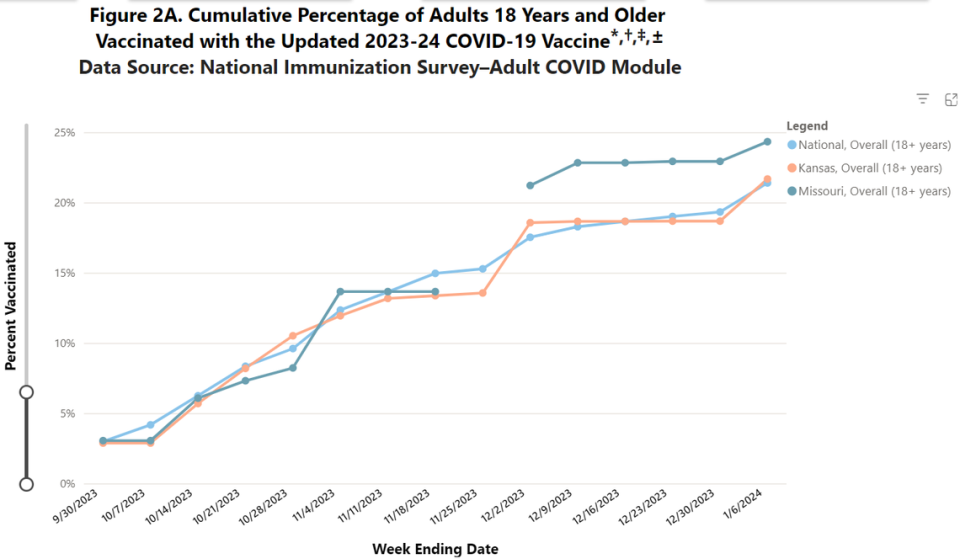For first time in months, COVID hospitalizations fall in KS and MO. Will it continue?
Reality Check is a Star series holding those in power to account and shining a light on their decisions. Have a suggestion for a future story? Email realitycheck@kcstar.com.
For the first time in months, weekly COVID-19 hospitalizations decreased in Missouri, Kansas and the United States overall during the second week of the year — the most recent period for which data is available.
Hospitalizations due to COVID-19 have been on the rise since late October and early November, with totals around New Year’s Day surpassing all weekly counts in 2023 in both Missouri and Kansas.
“I am optimistic that, in general, we are starting to see a waning of circulation of respiratory viruses including SARS-COV-2,” said Dr. Dana Hawkinson, medical director of infection prevention and control at the University of Kansas Health System.
“Here at the health system, we have seen a decrease the last two weeks in our number of patients admitted with active COVID-19. We have also seen, from national data from the CDC, that the number of visits to outpatient facilities for evaluation of respiratory (illness) has decreased (in) the last two weeks.”
Weekly hospitalization numbers are the most up-to-date measure of the virus’s impact locally, since new individual cases and test positivity rates are no longer consistently recorded.
Here’s what we know about the virus’s spread in Kansas City — and whether the latest surge could be on its way out.
Weekly hospitalizations drop in Missouri and Kansas
According to data from the U.S. Centers of Disease Control and Prevention (CDC), Missouri saw 782 hospitalizations during the second week of January. That’s fewer than the previous week’s total of 875.
Weekly hospitalizations had previously been showing an upward trend in the state since early October of 2023.
The same is true in Kansas, where weekly hospitalizations dropped from 324 to 206 in the first two weeks of the year after several months of increases.
As more data becomes available in the coming weeks, it will be easier to tell whether these one-week decreases mark the beginning of a larger downward trend in both states.
The two states mirror the U.S. as a whole, which saw its first decrease in weekly hospitalizations in 10 weeks during the second week of January. The latest national total for new COVID-19 hospitalizations was 32,861 as of Jan. 13, down from 36,399 during the first week of the year.
How is COVID-19 impacting Kansas City?
The University of Kansas Health System has seen a decrease in its COVID-19 patient totals in recent weeks, suggesting a downward trend in the metro that may mirror state and national numbers.
“We have 16 inpatients now, with three patients in the ICU,” said spokesperson Jessica Lovell in a news briefing Monday morning. “The good news is, our COVID count is down from last week.”
On Friday, the hospital reported 23 patients with active COVID-19 patients — and several weeks earlier, the number was in the low 30’s.
“We’re hoping we’ve hit a peak as far as number of admissions, not only for COVID but also influenza and RSV,” Hawkinson said in a Friday news briefing. “I think in the next couple weeks we’ll have a lot better information to see if that is true.”
CDC county-level data shows that Jackson County’s weekly numbers are relatively stable, totaling 154 new hospital admissions during the second week of January. Meanwhile, Johnson County’s COVID-19 hospitalizations decreased by 75% that week to a total of 25, and Wyandotte County’s increased by around 9% to a total of 62.
How vaccinated are Kansas and Missouri against new variants?
Nationwide uptake of the new COVID-19 vaccine has been slow, but vaccination rates are increasing in Missouri and Kansas.
According to data from the CDC’s national immunization survey, 24.3% of adults in Missouri have gotten the new shot. That’s higher than Kansas’ vaccination rate of 21.7%, which is just slightly above the national average of 21.4% as of Jan. 6.

Experts are now referring to new COVID-19 shots as new vaccines rather than boosters. That’s because the medical community expects to see newly updated shots every year, similar to the way flu shots work now.
“Calling it an updated COVID vaccine also reflects that we’re not just boosting existing immunity from previous vaccination; rather, the vaccine builds a new immune response to variants that are currently circulating,” wrote Aliza Rosen for Johns Hopkins’ Bloomberg School of Public Health.
However, if you see someone calling it a “booster,” know that it’s all the same shot. You can find vaccines near you by entering your ZIP code at Vaccines.gov.

